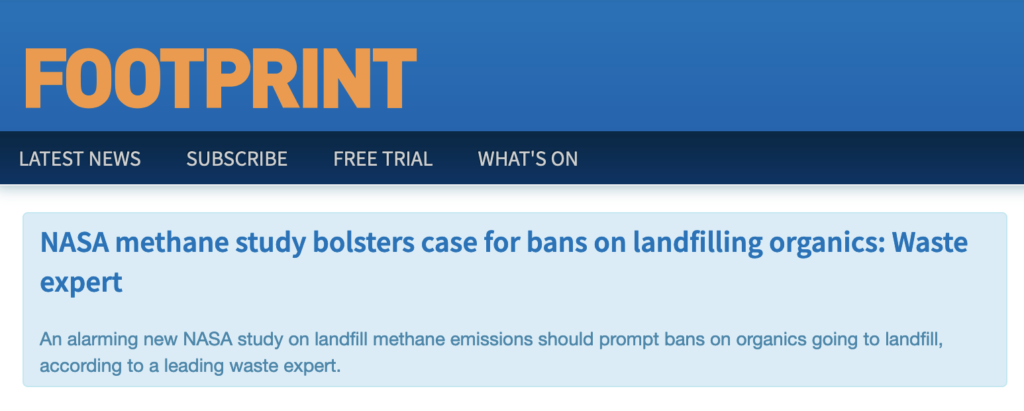Super-spreader landfills causing climate change
By Mike Ritchie, MRA Consulting Group

Organics decompose in landfill under anaerobic conditions to form methane, an extremely potent greenhouse gas (28 times more potent in forcing climate change than carbon dioxide).
Landfills represent 30% of all Australian methane emissions.
So, keeping organics out of landfill via an “Organics Revolution” will reduce Australia’s greenhouse footprint.
It seems that, as I found out recently, the science did catch up with that view a couple of years ago.
A study by NASA’s Jet Propulsion Laboratory and Scientific Aviation has found (via direct measurement of emissions) that “super emitter” landfill sites in the USA leak methane at rates as much as 6 times that calculated at the facility level using modelling such as the First Order Decay Model (FODM).
Put simply the problem of methane emissions from landfill is much bigger than the modelling tells us.
And that will come as no surprise to people who have used the FODM to estimate landfill emissions for the Australian Emissions Reduction Fund and National Greenhouse Emission Reporting scheme.
The models that are used to estimate landfill emissions include wildly disparate input assumptions, guesses about what waste was put in the ground up to 20 years ago, the mix of waste streams are estimated and the results depend on the State in which the landfill is located and a number of subsequent assumptions around climate and rainfall. Essentially, the modeller has the option to assume that a landfill in the north of NSW has the same climatic conditions as one in the south. This and other assumptions contribute to massive error bars in the estimates of emissions (and penalise some landfills over others).
This NASA study highlights that FODMs used in the USA are very poor predictors of the landfills’ emissions profile.
Tweet
MRA has been saying that for years.
Way back when the government was including landfills in the Carbon Pollution Reduction Scheme, we suggested that we use a simple proxy measure rather than the FODM. Simpler, cheaper and reliable. We suggested one tonne of waste into the landfill would generate 1 tonne of CO2-e (which is pretty close to the putrescible waste figure of 1.14) and that figure could be discounted by 50% with gas capture and flaring. We didn’t win the debate. But that is not the point of this story.
The right place for organics (food, garden, timber, wood etc) is back to farmers as compost or into anaerobic digestion to generate green energy.
We have the poorest soils on the planet and yet we landfill more than 7 MT per year of perfectly good organics. Why?
Because the economics of landfill in Australia is still broken.
It is still cheaper to landfill food waste than to recycle it, almost everywhere.
It is not banned from landfill anywhere. The landfill levies are supposed to drive it out of landfill, but they are still not high enough to generate the behaviour change we need.
We should not blame households, Councils or businesses for this. They are making rational economic decisions. It is government that sets the policies, levies and regulations that drive recycling (or not) of organics.
The NASA study found that super-emitter landfills accounted for 40% of the measured point source emissions in California, exceeding fossil fuel and agricultural generation of methane point source emissions.
That is likely to be true here as well but do not regularly measure methane emissions from landfill. We only model it.
Methane concentrations in the atmosphere have been rising rapidly, increasing the challenge of achieving the Paris Agreement targets. The study indicates that landfills are likely playing a bigger role in accelerating global warming, than regulators have previously believed.
NSW now requires large commercial operators to have organics collection. This is a first positive step towards commercial organics diversion. However, it is not enough. It is time for all Governments (Federal, State and Local) to step up with serious controls on organic waste to landfill, including both household and commercial sources.
While some movement is afoot, it is neither comprehensive, enforceable or sufficient to drive organics from landfill.
As always, we welcome your feedback on this, or any other topic on ‘The Tipping Point’.
This article has been quoted by the following media outlets:




